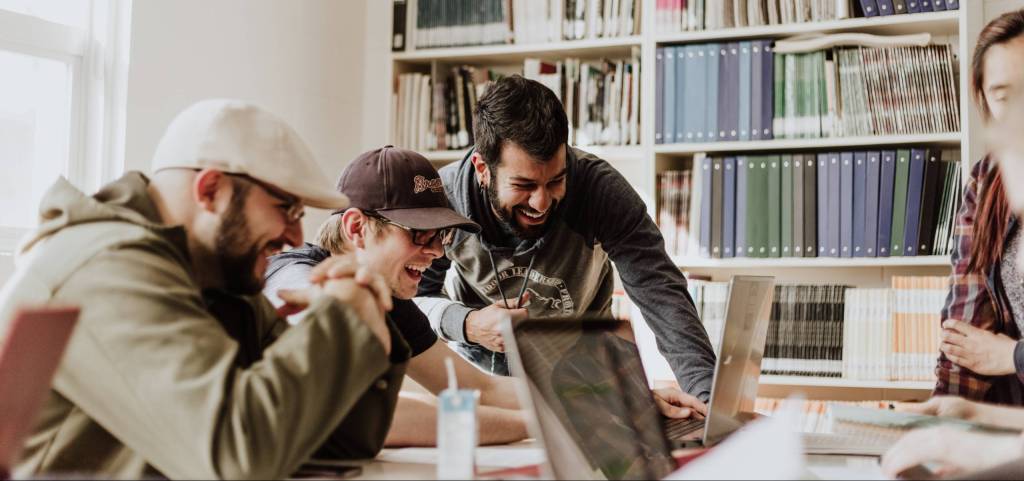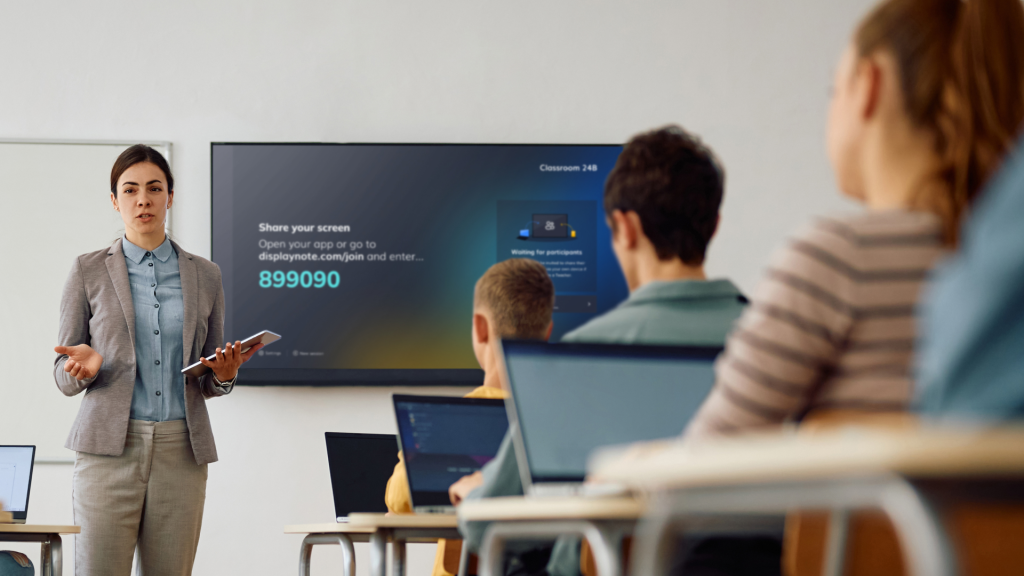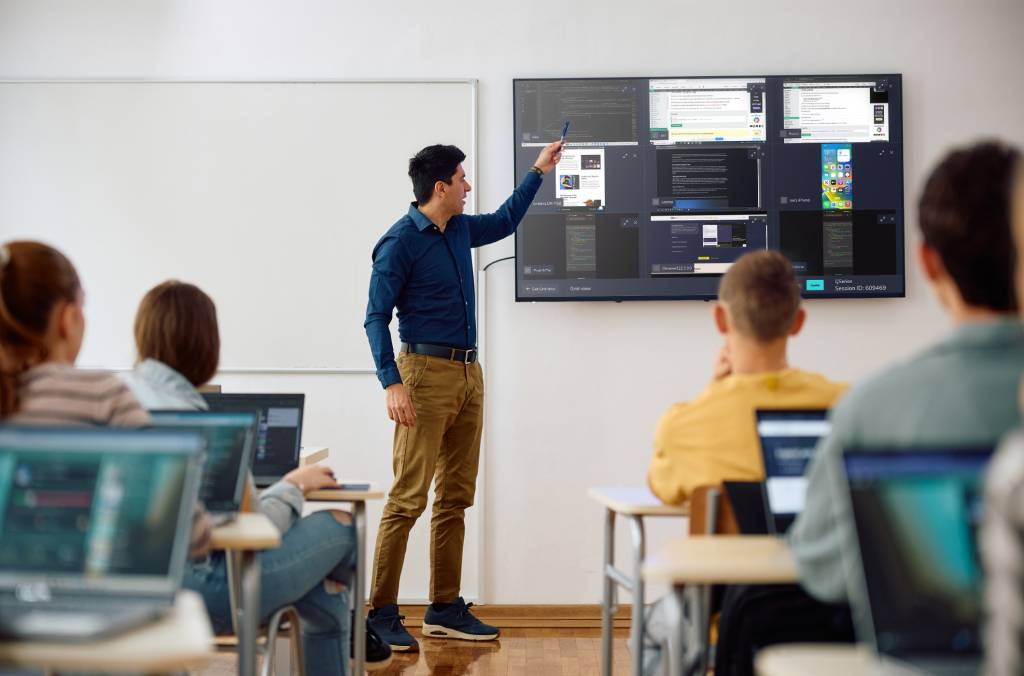
DisplayNote Dialogues: Dr. Anthea Irwin: The Pandemic as a Pilot Study for Blended Learning
 Julie Adams
•
Jun 16, 2021
Julie Adams
•
Jun 16, 2021
This is the first in our DisplayNote Dialogues Series featuring articles from educators and industry experts worldwide. This article is written by Dr. Anthea Irwin.
Dr. Irwin is a Lecturer in Communication at Ulster University, Course Director of their BSc Hons Communication, Advertising, and Marketing degree (from August 2021), and owner at Communicanny, offering content solutions for small businesses.

“Blended learning is not new. It’s something I’d wanted to explore more for the majority of my career (20 years and counting). The mixture of face-to-face and online learning really attracted me. I knew it could provide more flexibility, deeper learning, and a richer relationship between my students and I. (That last point seems counterintuitive, I know, but bear with me).
I’ve dipped my toes in in the past, hosting individual and smaller group tasks online between classes. I just could never find the time and space in my lecturing workload to make it happen more holistically. But like many other educators over the past year and a half, I’ve had to. And guess what? It was brilliant. Yes – it was a massive challenge, but it was also a pilot for the rest of my career.
I’ve realised that online learning does not have to be ‘lesser.’ On-campus versus online is not an ‘either or’ (the clue is in the name, ‘blended’ learning). Like all the best pairings, one will always enhance the other.
Rebalancing priorities
The arrival of a global pandemic made us all rethink our priorities, didn’t it? Universities were no different. For me, it’s a no-brainer that educating students is what universities are for. Maintaining that priority is hard, though, when so many other tasks compete for our attention.
Planning, doing, writing up, and re-writing research. Reviewing other people’s research. Managing budgets. Organising academic and community events. Marketing our courses. Sharing our news with our local community. And the huge amount of admin that comes with working in a large institution…Phew.
A lecturer’s time in the classroom is only a small proportion of the work we do. But over this past year and a half – that work – or the equivalent of that work – took several times as long as before, so something had to give. I’m delighted that in our team, we made sure that ‘the something’ wasn’t the students’ learning. Instead, we rebalanced our priorities and gave learning and teaching the time it needed and deserved. With this, I made some really important discoveries along the way.
More flexibility
The courses I teach across were completely online with a mixture of asynchronous and synchronous delivery. Some things the students do without the lecturer present (like watching pre-prepared content and doing some online tasks), and some things they do with the lecturer present (seminar or workshop time in an online space). The amount of material and time on task isn’t less; they’re just different.
Crucially, they’re flexible. A good proportion of the work can be done anytime, anywhere. And that works for students. Those with caring responsibilities can balance the demands with their uni work. And whether we like it or not, many students work 20+ hours in part-time jobs (student fees and student funding are not what they were ‘in my day’). The flexibility of online learning means they can find a schedule that works for both types of work.

Deeper learning
The material is different in its planning and execution, too. Making online content for students is not as simple as sitting down in front of a mic and talking through your lecture slides. Or at least it shouldn’t be. Have you ever tried to sit through anything online for two hours that wasn’t a drama, movie, or televised sport (that you’re interested in)? No one has the concentration for that, so we shouldn’t expect our students to. This meant that I had to rethink the structure of what I was teaching.
I ‘curated’ the material differently, if you will. Several shorter pieces rather than one long one. Much less text and many more images as the visuals to accompany what I was saying. Planning what I said so that it drew the students in with questions, direct address, and lots of humour. Some ‘piece to camera’ sections to humanise it. Transcripts of what I said.
And here’s the thing – my students loved it. The rebalancing of text and visual worked for those who are visual learners. Having the transcripts as a basis for notes worked for those who live with dyslexia. Being able to watch and listen again worked for everyone. There is no doubt in my mind that my students’ learning was deeper in this format.

A richer relationship
In my blended learning daydreams of the past, I’ve always foreseen keeping seminar or workshop sessions on-campus so that we can really get stuck in to applying the ideas and have a bit of fun together. To begin with, shifting these sessions online was a challenge, I’m not going to lie. But the experience of doing them in that way reminded me not to presume that my perception is shared by others and to explore everyone’s experience.
I was wrong to see the sea of initials on my screen (or profile pics if I was lucky) as a lack of engagement. Students did speak out if asked individually (though the vast majority of cameras still didn’t go on!). And this was all the more successful with structured pre-session tasks that meant they were ready to do so, sometimes sharing their screens to talk the rest of us through what they’d been doing.
Perhaps the most striking thing was the response to electronic interactivity. I used a lot of opinion polls, quizzes, mood scales, and free text answer activities. To begin with, I used them to reinforce students’ learning and, I guess, if I’m honest, I used them for fear that students wouldn’t speak to me or to bring a bit of fun to what might otherwise be a drab affair. But I quickly recognised that these types of activities should be at the heart of what I do. Why? Because they’re inclusive.
I was worried about no students speaking in class; I should have been worried about not every student speaking in class. A subtle difference grammatically, perhaps, but a much more crucial one in practice. There will always be some students who are more comfortable speaking up in class. More often than not, those who don’t speak as much are our young women, our BAME students, and our less affluent students. I can, and will, keep working to enable each of these students to find their spoken voices. In the meantime, using these electronic tools enables them to use their voices differently and as much as any other student. It allows me to have a richer relationship with all my students.
Truly blended learning
This brings me back to the fact that online and on-campus is not an ‘either or’. In its simplest form, blended learning refers to doing some things online and some things on campus. Going forward, I plan to keep posting recorded content and online tasks and have seminar classes on campus.
But the real win of blended learning comes, I think, when it is truly blended. Bringing electronic interaction into the face-to-face on-campus context makes for a better experience for everyone. Every student can be involved. The lecturer can get more of a sense of the understanding and opinion in the room. And the ‘conversation’ – albeit in a different mode – makes for partnership learning, something every lecturer strives for.
DisplayNote’s classroom tools are perfect for this. The lecturer no longer needs to do all the sharing or use a ‘one size (doesn’t) fit(s) all’ software. DisplayNote Broadcast allows every student to view the material on their own screen, making content more clear and accessible.
Plus, using Broadcast in conjunction with DisplayNote Montage allows each student to share their screen back to the class via their browser, which is easy and empowering. The flexibility DisplayNote brings to the learning space allows the conversation to flow, the learning to deepen, and the relationship to grow richer with every class.
The perfect blend, don’t you think?”
Dr. Anthea Irwin is a Lecturer in Communication at Ulster University, Course Director of their BSc Hons Communication, Advertising, and Marketing degree (from August 2021), and owner at Communicanny, offering content solutions for small businesses. You can find out more at www.communicanny.com or by visiting www.facebook.com/communicanny.
Want to stay in the loop?
Keep up-to-date with everything DisplayNote – including new releases, job openings, and customer giveaways.
Don’t worry, we’ll not spam you and we’ll never share your email with anyone






